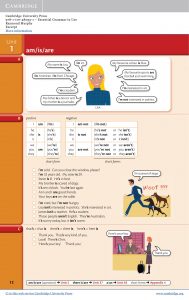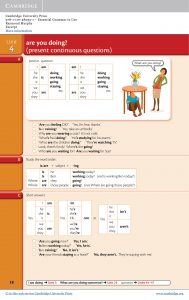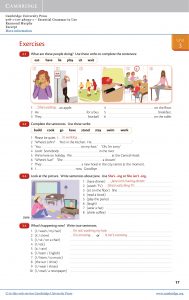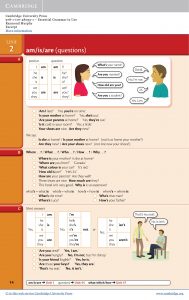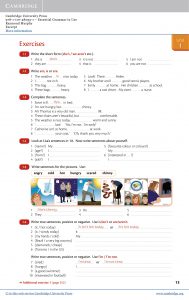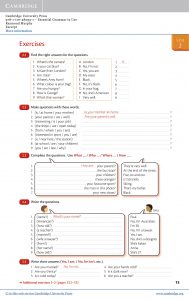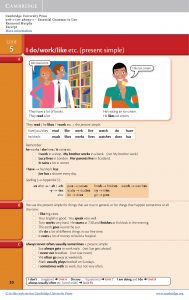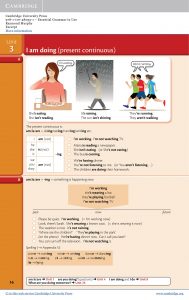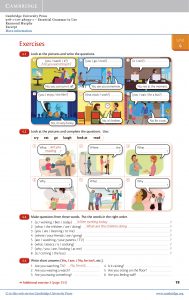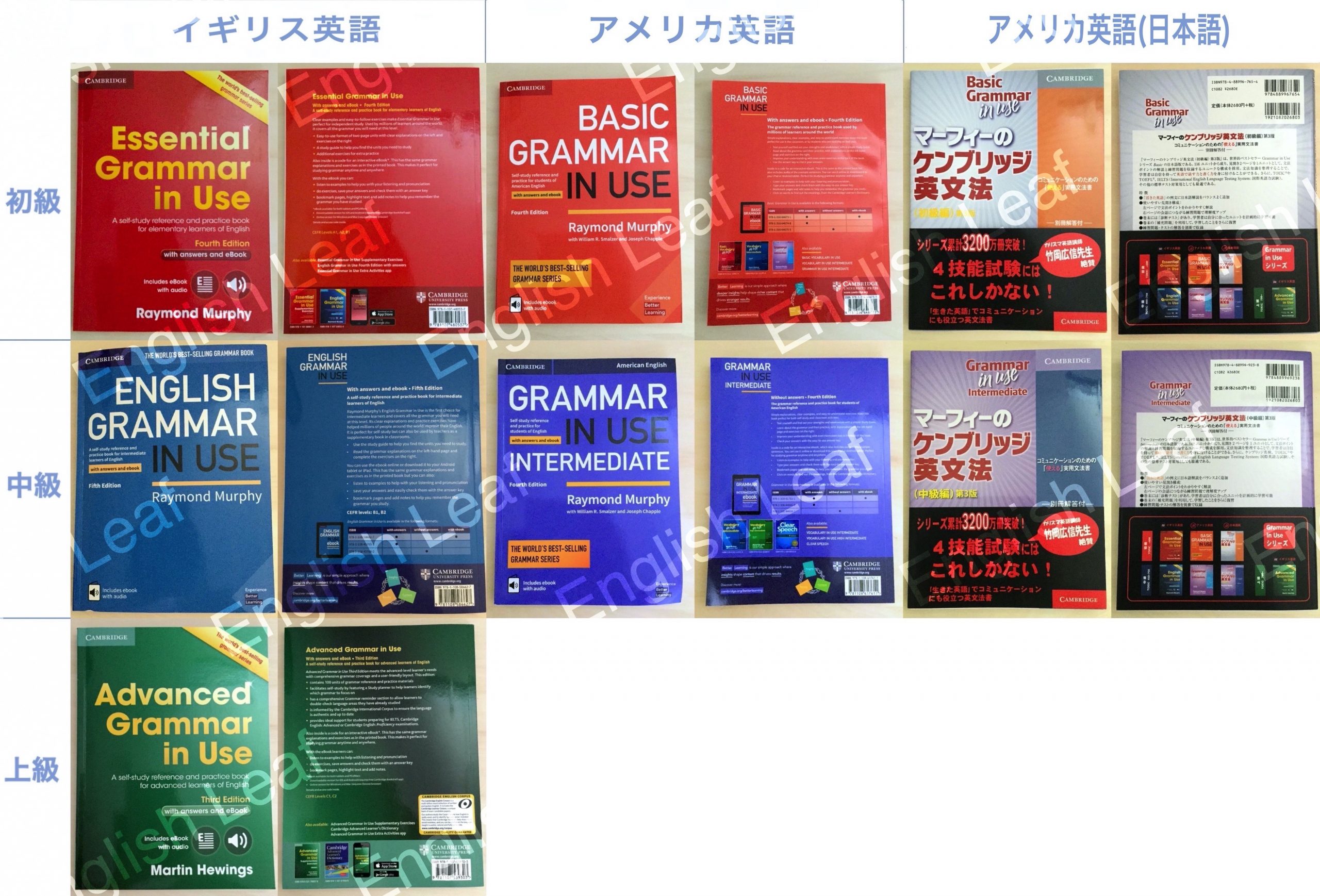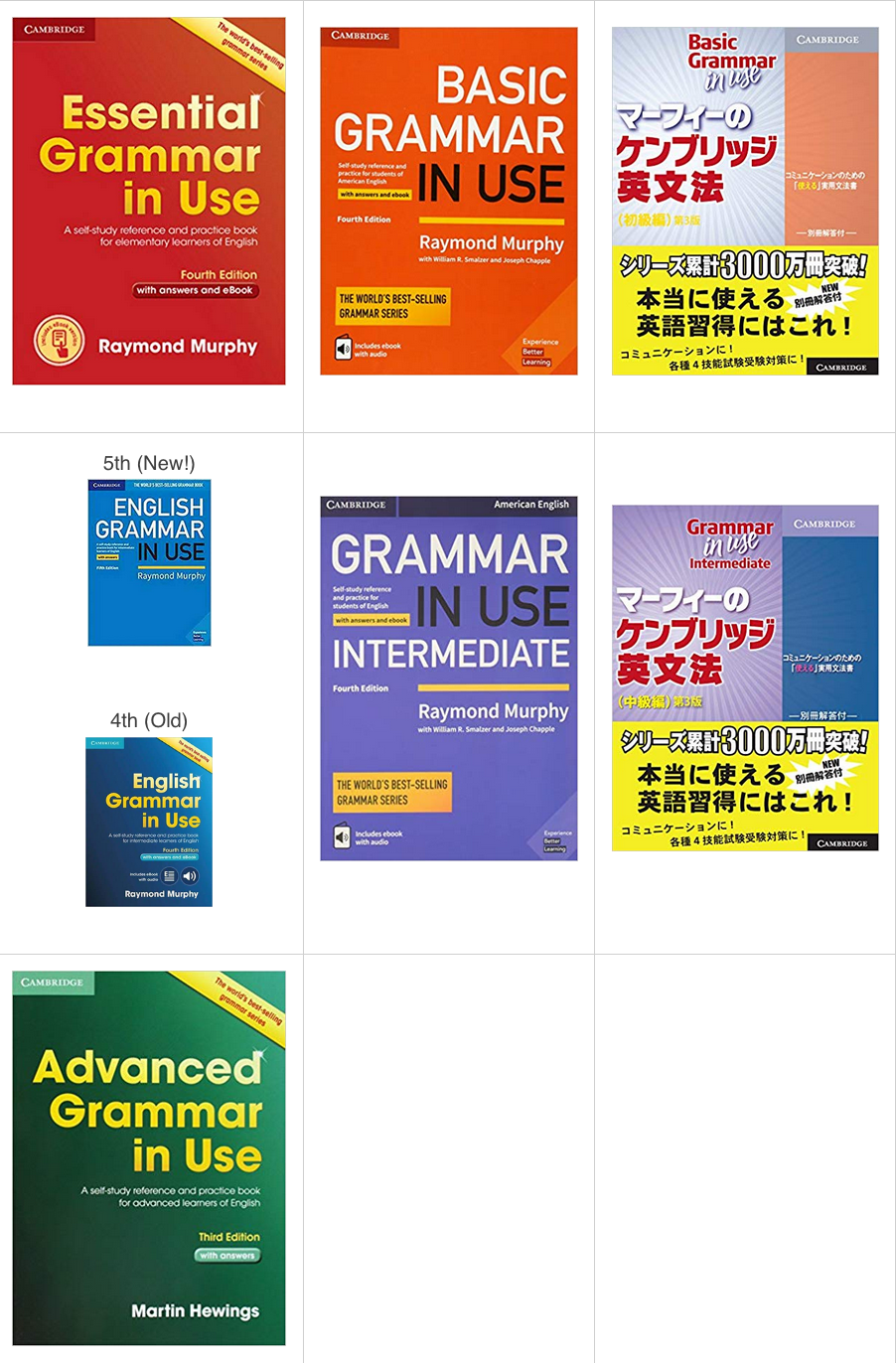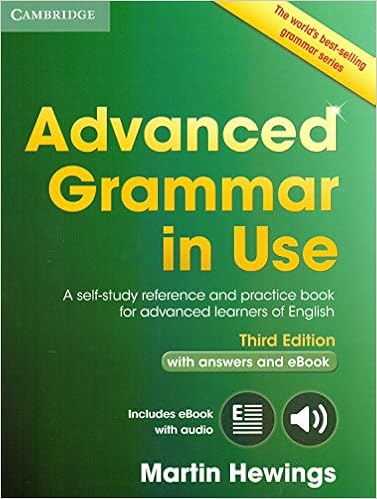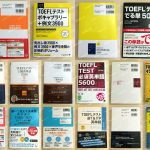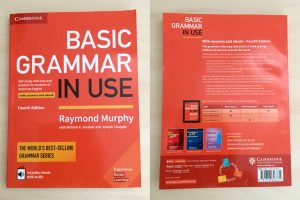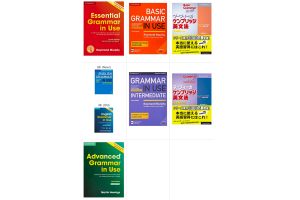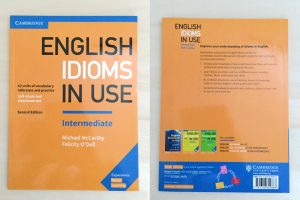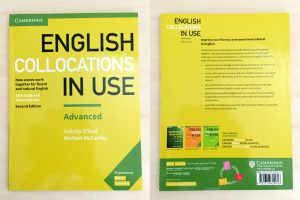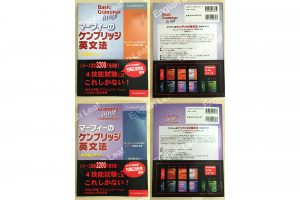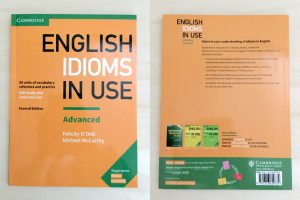English Grammar in Useシリーズの種類を確認しよう
English Grammar in Useシリーズには、レベルに応じて様々な種類が存在します。そのため、購入するときに悩んでしまうこともしばしば…。そこで、各書籍についてわかりやすく違いや詳細を解説していくので、購入する際の参考にしてみてください。まずは、レベルと英語の種類ごとにザックリと分けた下記の表を見てください。
目次をはじめに見てみたいという方は下記から閲覧できます。
・イギリス英語版
初級:目次/テキスト(中身/内容)
中級:目次/テキスト(中身/内容)
上級:目次/テキスト(中身/内容)
・日本語版(内容は上記アメリカ英語のものと同等です)
初級:目次
中級:目次
【確認 – 分かりづらい「Englsh Grammar in Use」は種類が豊富】も確認する
| アクセント | イギリス英語 | アメリカ英語 | アメリカ英語 (日本語訳) |
| タイプ | ebook付き CD付き、 解答のみ |
CD付き | 別冊解答集付き |
|
初級(Essential
・Basic) |
 |
 |
 |
|
中級
(Intermediate) |
 |
 |
 |
|
上級
(Advanced) |
 |
以上のようにザックリと種類を分けましたが、実際にGrammar in Useシリーズには、他にも解答なし版や旧版、25周年記念版なども存在します。ただし、これらは一般の英語学習者には無縁のものであるため、コレクターでない限りは購入する際に選択肢に入れる必要はありません。 例えば、解答なし版であれば、学校などの教材で生徒に配ることを前提に設計されています。
ということもあり、シリーズ全てのバージョンを紹介するとキリがないので、この記事ではセルフスタディ用(独学用)を前提としたバージョンの最新版を中心に紹介していきます。
さて、購入を検討している人は、まず最初にレベルを選択する必要があります。簡単すぎても難しすぎても自分自身の英語力の向上に繋がりません。Grammar in Useシリーズには、Essential(初級)、Intermediate(中級)、Advanced(上級)とレベルが分かれています(日本語版以外は全て英語で書かれています)。また、イギリス英語とアメリカ英語の2種類があります。イギリス英語版は初級から上級、アメリカ英語版には初級と中級のレベルがあります。なお、日本語版はアメリカ版を日本語に翻訳したものです。また、直近ではIntermediateで5th editonが発売されました。

【イギリス英語版】
初級:Essential Grammar in Use(テキストのみ/CD付き/ebook付き)
中級:English Grammar in Use(テキストのみ/CD付き/ebook付き)
上級:Advanced Grammar in Use(テキストのみ/CD付き/ebook付き)
【アメリカ英語版】
基礎:Basic Grammar in Use(CD付き)
中級:Grammar in Use Intermediate(CD付き)
【日本語版(アメリカ英語版の日本語訳)】
基礎:Basic Grammar in Use(解答つき)
中級:Grammar in Use Intermediate(解答つき)
Grammar in Useの選び方
どんな種類が販売されているのかを理解したところで、次にGrammar in Useシリーズの選び方について解説していきます。購入を検討されている人は、次のポイントをチェックしてください。そうすれば自分に合った1冊を選ぶことができるでしょう。
【1】現在の自分の英語レベルと将来的に目指したいレベル
【2】イギリス英語とアメリカ英語のどちらを学びたいか(アメリカ英語なら日本語版と英語版のどちらか)
【3】eBook(CD)の音源が必要か? または答えだけでも良いのか?
以上の3つのポイントについて考えてみてください。「もし、1冊選ぶならどれ?」と言うのであれば、間違いなくイギリス英語版のIntermediate(中級)をオススメします。なぜなら、Intermediate(中級)のバランスが最良だからです。
【1】自分に合ったレベル、または目指したいレベル
イギリス英語版を選ぶ場合は、英語のスキルに応じてEssential(初級)、Intermediate(中級)、Advanced(上級)の3つのレベルから選択できます。赤・青・緑と色分けされているので。間違わずに目的の本を選べるでしょう。また、英語を学ぶときに、自身のレベルよりも少し上くらいの参考書が最も効果的です。もしくは、選ぶときのポイントに日本語で書かれた参考書を終えた後のステップとして、English Grammar in Useシリーズを使う方法などもあります。
一方、アメリカ英語版は初級と中級の2種のみです。Grammar in Useシリーズはケンブリッジ出版という海外の出版社が発行している書籍です。日本語版以外であれば、どれを選んだとしても英語を英語で学ぶことができます。そのため、原則的に英語の解説を理解するのに十分な英語力が必要であることを覚えておいてください。
個人差がありますが、一番人気のIntermediate(中級)を読み進めていくならば、TOEICで550点以上のスコアが必要だと感じます。スコアが550点以下であれば、まずはEssential(初級)から取り組むと良いでしょう。
【2】イギリス英語か? それともアメリカ英語か?
そもそも、市販の英文法書はイギリス英語とアメリカ英語に分けることができます。Grammar in Useシリーズは、版元がケンブリッジ出版ということもあってイギリス英語が大元です。イギリス英語版とアメリカ英語版の詳細な違いは後述しますが、あまり心配する必要はないかと思います。レベルとebookやCD付きなどパターンが多いイギリス英語版から選択すると良いと思います。また、必ず新版はイギリス英語版から発売されます。
【3】eBook(CD)の音源は必要か?
「ebook(CD)付きか」、「答えのみか」で悩んでいる場合は、値段も変わってくることもあり、自身の学習スタイルと照らし合わせて考えると良いでしょう。あくまでも文法書としてのみ利用するのならば答えのみ版。リスニングやスピーキング対策としても使いたい場合は、ebook(CD)版を選ぶと良いと思います。
世界的ベストセラーであるGrammar in Useシリーズは、1985年に出版されたEnglish Grammar in Use(イギリス英語版の中級)から始まり、コミュニケーションに使える実用英文法書として、現在でも世界中の英語学習者から絶大な支持を得ています。文法についてより深いレベルで身につけたい人は、この記事を参考にしてみてください。
目次 – 学習手帳付 日本限定版 English Grammar in Use 5th edition Book
目次 – 学習手帳付 日本限定版 English Grammar in Use 5th edition Bookで確認する
も確認する。
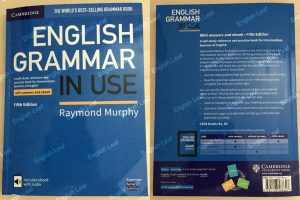
Contents
Thanks
To the student
ebook
To the teacher
Present and past
1 Present continuous (I am doing)
2 Present simple (I do)
3 Present continuous and present simple 1 (I am doing and I do)
4 Present continuous and present simple 2 (I am doing and I do)
5 Past simple (I did)
6 Past continuous (I was doing)
Present perfect and past
7 Present perfect 1 (I have done)
8 Present perfect 2 (I have done)
9 Present perfect continuous (I have been doing)
10 Present perfect continuous and simple (I have been doing and I have done)
11 how long have you (been) … ?
12 for and since when …? and how long …?
13 Present perfect and past 1 (I have done and I did)
14 Present perfect and past 2 (I have done and I did)
15 Past perfect (I had done)
16 Past perfect continuous (I had been doing)
17 have and have got 18 used to (do)
Future
19 Present tenses (I am doing / I do) for the future
20 I’m going to (do)
21 will and shall 1
22 will and shall 2
23 I will and I’m going to
24 will be doing and will have done
25 when I do and when I’ve done if and when
Modals
26 can, could and (be) able to
27 could (do) and could have done)
28 must and can’t
29 may and might 1
30 may and might 2
31 have to and must
32 must mustn’t needn’t
33 should 1
34 should 2
35 I’d better … it’s time …
36 would
37 can/could/would you …? etc. (Requests, offers, permission and invitations)
IF YOU ARE NOT SURE WHICH UNITS YOU NEED TO STUDY. USE THE STUDY GUIDE ON PAGE 326.
if and wish
38 if I do… and if I did…
39 if I knew … I wish I knew …
40 if I had known … I wish I had known …
41 wish
Passive
42 Passive 1 (is done / was done)
43 Passive 2 (be done / been done / being done)
44 Passive 3
45 it is said that … he is said to … he is supposed to …
46 have something done
Reported speech
47 Reported speech 1 (he said that …)
48 Reported speech3
Questions and auxiliary verbs
49 Questions 1
50 Questions 2 (do you know where … ? / he asked me where …)
51 Auxiliary verbs (have/do/can etc.) I think so / I hope so etc.
52 Question tags (do you? isn’t it? etc.)
-ing and to …
53 Verb + -ing (enjoy doing / stop doing etc.)
54 Verb + to … (decide to … / forget to … etc.)
55 Verb (+ object) + to… (I want you to …)
56 Verb + -ing or to … 1 (remember, regret etc.)
57 Verb + -ing or to … 2 (try, need, help)
58 Verb + -ing or to … 3 (like / would like etc.)
59 prefer and would rather
60 Preposition (in/for/about etc.) +-ing
61 be/get used to … (I’m used to …)
62 Verb + preposition + -ing (succeed in -ing/insist on-ing etc.)
63 there’s no point in -ing, it’s worth -ing etc.
64 to …, for … and so that …
65 Adjective + to …
66 to … (afraid to do) and preposition + -ing (afraid of -ing)
67 see somebody do and see somebody doing
68 -ing clauses (He hurt his knee playing football.)
Articles and nouns
69 Countable and uncountable 1
70 Countable and uncountable 2
71 Countable nouns with a/an and some
72 a/an and the
73 the 1
74 the 2 (school / the school etc.)
75 the 3 (children / the children)
76 the 4 (the giraffe / the telephone / the old etc.)
77 Names with and without the 1
IF YOU ARE NOT SURE WHICH UNITS YOU NEED TO STUDY, USE THE STUDY GUIDE
78 Names with and without the 2
79 Singular and plural
80 Noun + noun (a bus driver/ a headache)
81 ‘s (your sister’s name) and of … (the name of the book)
Pronouns and determiners
82 myself/yourself/themselves etc.
83 a friend of mine my own house on my own / by myself
84 there … and it …
85 some and any
86 no/none/any nothing/nobody etc.
87 much, many, little, few, a lot, plenty
88 all / all of most / most of no / none of etc.
89 both / both of neither / neither of either / either of
90 all every whole
91 each and every
Relative clauses
92 Relative clauses 1: clauses with who/that/which
93 Relative clauses 2: clauses with and without who/that/which
94 Relative clauses 3: whose/whom/where
95 Relative clauses 4: extra information clauses (1)
96 Relative clauses 5: extra information clauses (2)
97 -ing and -ed clauses (the woman talking to Tom, the boy injured in the accident)
Adjectives and adverbs
98 Adjectives ending in -ing and -ed (boring/bored etc.)
99 Adjectives: a nice new house, you look tired
100 Adjectives and adverbs 1 (quick/quickly)
101 Adjectives and adverbs 2 (well, fast, late, hard/hardly)
102 so and such
103 enough and too
104 quite, pretty, rather and fairly
105 Comparative 1 (cheaper, more expensive etc.)
106 Comparative 2 (much better/ any better etc.)
107 Comparative 3 (as … as / than)
108 Superlative (the longest, the most enjoyable etc.)
109 Word order 1: verb + object; place and time
110 Word order 2: adverbs with the verb
111 still any more yet already
112 even
Conjunctions and prepositions
113 although though even though in spite of despite
114 in case
115 unless as long as provided
116 as (as I walked … / as I was … etc.)
117 like and as
118 like as if
119 during for while
120 by and until by the time …
IF YOU ARE NOT SURE WHICH UNITS YOU NEED TO STUDY, USE THE STUDY GUIDE ON PAGE 326.
Prepositions
121 at/on/in (time)
122 on time and in time at the end and in the end
123 in/at/on (position) 1
124 in/at/on (position) 2
125 in/at/on (position) 3
126 to, at, in and into
127 in/on/at (other uses)
128 by
129 Noun + preposition (reason for, cause of etc.)
130 Adjective + preposition 1
131 Adjective + preposition 2
132 Verb + preposition 1 to and at
133 Verb + preposition 2 about/for/of/after
134 Verb + preposition 3 about and of
135 Verb + preposition 4 of/for/from/on
136 Verb + preposition 5 in/into/with/to/on
Phrasal verbs
137 Phrasal verbs 1 Introduction
138 Phrasal verbs 2 in/out
139 Phrasal verbs 3 out
140 Phrasal verbs 4 on/off (1)
141 Phrasal verbs 5 on/off (2)
142 Phrasal verbs 6 up/down
143 Phrasal verbs 7 up (1)
144 Phrasal verbs 8 up (2)
145 Phrasal verbs 9 away/back
Appendix 1 Regular and irregular verbs
Appendix 2 Present and past tenses
Appendix 3 The future
Appendix 4 Modal verbs (can/could/will/would etc.)
Appendix 5 Short forms (I’m / you’ve / didn’t etc.)
Appendix 6 Spelling 298 Appendix 7 American English
Additional exercises
Study guide
Key to Exercises
Key to Additional exercises
Key to Study guide
Index
IF YOU ARE NOT SURE WHICH UNITS YOU NEED TO STUDY, USE THE STUDY GUIDE ORIPAR
Thanks
This is the fifth edition of English Grammar in Use. I wrote the original edition when I was a teacher at th Swan School of English, Oxford. I would like to repeat my thanks to my former colleagues and students the school for their help, encouragement and interest at that time.
Regarding the production of this fifth edition, I would like to thank Rebecca Winthrop and Chris Capper.
Design & Illustrations
Q2A Media Services Pvt. Ltd.
Digital development
Datamatics Ltd.
Audio production
The Soundhouse Studios Ltd.
To the student
This book is for students who want help with English grammar. It is written for you to use without a teacher.
The book will be useful for you if you are not sure of the answers to questions like these:
What is the difference between I did and I have done?
When do we use will for the future?
What is the structure after / wish?
When do we say used to do and when do we say used to doing?
When do we use the?
What is the difference between like and as?
These and many other points of English grammar are explained in the book, and there are exercises on each point.
Level
The book is intended mainly for intermediate students (students who have already studied the basic grammar of English). It concentrates on those structures that intermediate students want to use, but that often cause difficulty. Some advanced students who have problems with grammar will also find the book useful.
The book is not suitable for elementary learners.
How the book is organised
There are 145 units in the book. Each unit concentrates on a particular point of grammar. Some problems (for example, the present perfect or the use of the) are covered in more than one unit. For a list of units, see the Contents at the beginning of the book.
Each unit consists of two facing pages. On the left there are explanations and examples; on the right there are exercises. At the back of the book there is an Answer Key for you to check your answers to the exercises (page 336).
There are also seven Appendices at the back of the book (pages 292-301). These include irregular verbs, summaries of verb forms, spelling, and American English.
Finally, there is a detailed Index at the back of the book (page 373).
How to use the book
The units are not in order of difficulty, so it is not intended that you work through the book from beginning to end. Every learner has different problems, and you should use this book to help you with the grammar that you find difficult.
It is suggested that you work in this way:
Use the Contents and/or Index to find which unit deals with the point you are interested in.
If you are not sure which units you need to study, use the Study guide on page 326.
Study the explanations and examples on the left-hand page of the unit you have chosen.
Do the exercises on the right-hand page.
Check your answers with the Key.
If your answers are not correct, study the left-hand page again to see what went wrong.
You can, of course, use the book simply as a reference book without doing the exercises.
Additional exercises
At the back of the book there are Additional exercises (pages 302-325). These exercises bring together some of the grammar points from a number of different units. For example, Exercise 16 brings together grammar points from Units 26-36. You can use these exercises for extra practice after you have studied and practised the grammar in the units concerned.
ebook
You can buy this book with or without an ebook. The ebook has the same grammar explanations and exercises as the book.
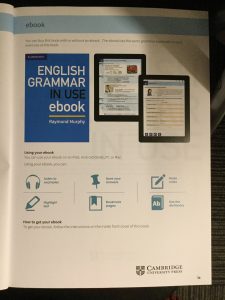
Using your ebook
You can use your ebook on an iPad, Android tablet, PC or Mac.
Using your ebook, you can:
Listen to examples
Save your answers
Make notes
Highlight text
Bookmark pages
Use the dictionary
How to get your ebook
To get your ebook, follow the instructions on the inside front cover of this book.
CAMBRIDGE GS UNIVERSITY PRESS
To the teacher
English Grammar in Use was written as a self-study grammar book, but teachers may also find it useful as additional course material in cases where further work on grammar is necessary.
The book will probably be most useful at middle and upper-intermediate levels (where all or nearly all of the material will be relevant), and can serve both as a basis for revision and as a means for practising new structures. It will also be useful for some more advanced students who have problems with grammar and need a book for reference and practice. The book is not intended to be used by elementary learners.
The units are organised in grammatical categories (Present and past, Articles and nouns, Prepositions etc.). They are not ordered according to level of difficulty, so the book should not be worked through from beginning to end. It should be used selectively and flexibly in accordance with the grammar syllabus being used and the difficulties students are having.
The book can be used for immediate consolidation or for later revision or remedial work. It might be used by the whole class or by individual students needing extra help. The left-hand pages (explanations and examples) are written for the student to use individually, but they may of course be used by the teacher as a source of ideas and information on which to base a lesson. The student then has the left-hand page as a record of what has been taught and can refer to it in the future. The exercises can be done individually, in class or as homework.
Alternatively (and additionally), individual students can be directed to study certain units of the book by themselves if they have particular difficulties not shared by other students in their class. Don’t forget the Additional exercises at the back of the book (see To the student).
This fifth edition of English Grammar in Use has been revised and updated. There are no new units, but some of the exercises have been rewritten or replaced.
An edition of English Grammar in Use without the key is also available. Some teachers may prefer this for use with their students.
The book is sold with or without an ebook. The ebook contains the same explanations and exercises as the book. It can be used on an iPad, Android tablet, PC or Mac. Using the ebook, students can listen to examples, save their answers, take notes, highlight text, bookmark pages and use a dictionary.
サンプルページEnglish Grammar in Use
サンプルページ – 学習手帳付 日本限定版 English Grammar in Use 5th edition Bookで確認する
も確認する。
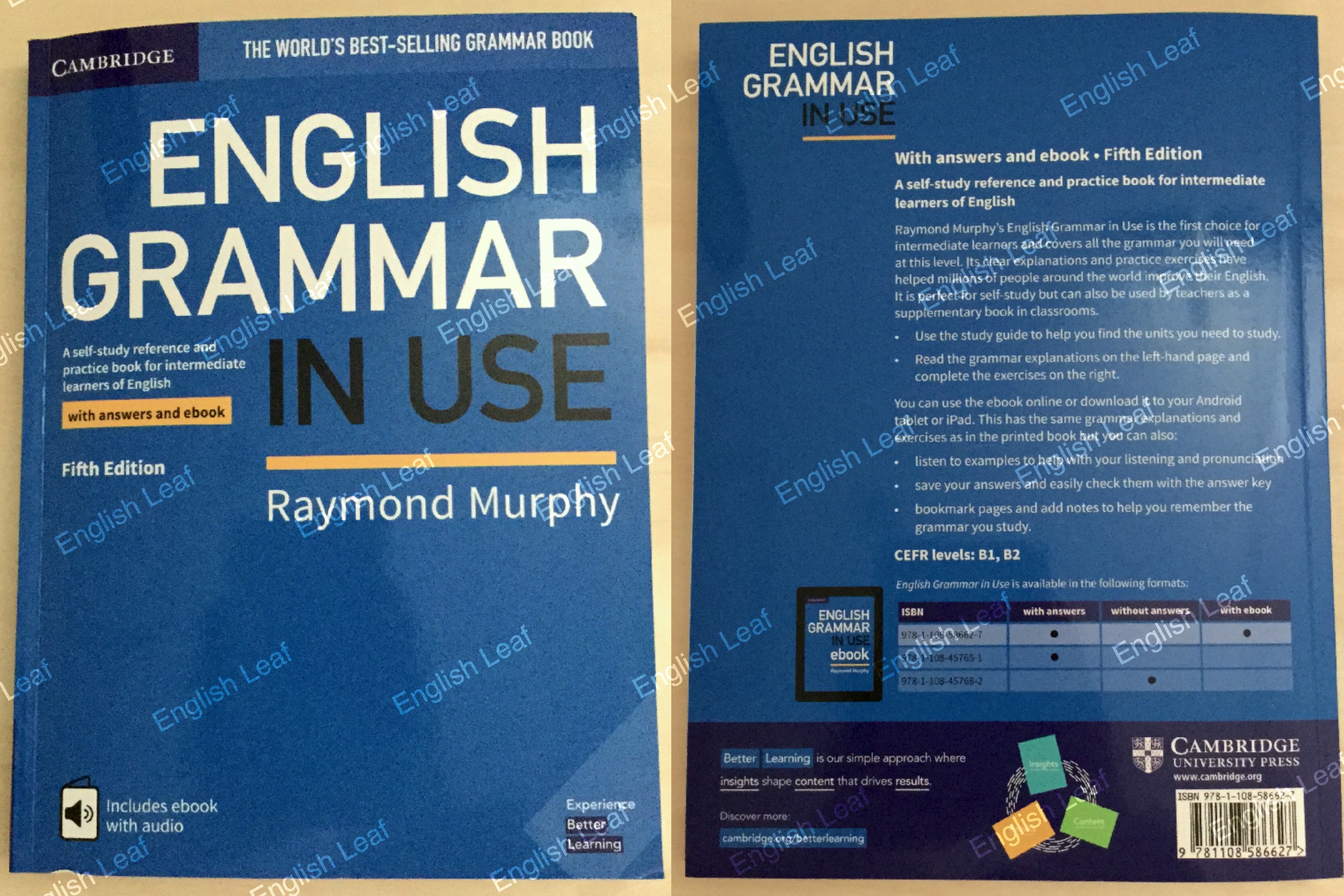

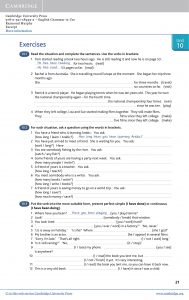

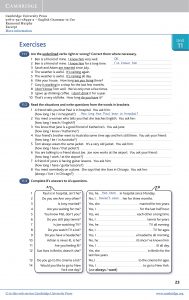
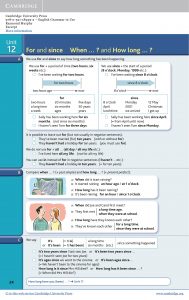
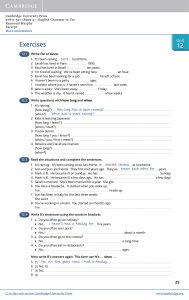
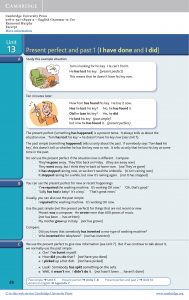
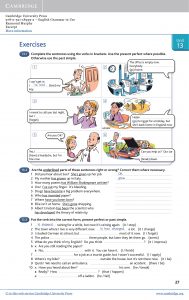
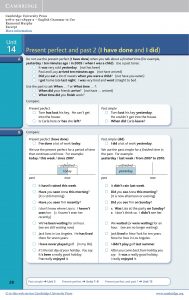
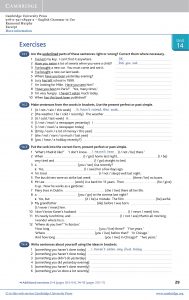
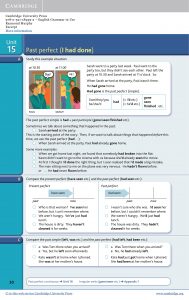

目次 – Advanced Grammar in Use Book with Answers and Interactive eBook
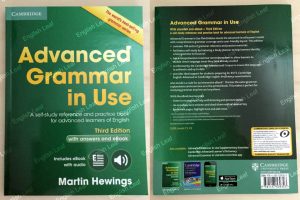
Contents
Thanks
To the student
To the teacher
Tenses
1 Present continuous and present simple 1
2 Present continuous and present simple 2
3 Past simple and present perfect
4 Past continuous and past simple
5 Past perfect and past simple
6 Present perfect continuous and present perfect
7 Past perfect continuous, past perfect and past continuous
8 Present and past time: review
The future
9 Will and be going to
10 Present simple and present continuous for the future
11 Future continuous and future perfect (continuous)
12 Be to + infinitive; be about to + infinitive
13 Other ways of talking about the future
14 The future seen from the past
Modals and semi-modals
15 Can, could, be able to and be allowed to
16 Will, would and used to
17 May and might
18 Must and have (got) to
19 Need(n’t), don’t need to and don’t have to
20 Should, ought to and had better
Linking verbs, passives, questions
21 Linking verbs: be, appear, seem; become, get, etc.
22 Forming passive sentences 1
23 Forming passive sentences 2: verb + -ing or to-infinitive
24 Using passives
25 Reporting with passives; It is said that …
26 Wh-questions with who, whom, which, how and whose
27 Negative questions; echo questions; questions with that-clauses
Verb complementation: what follows verbs
28 Verbs, objects and complements
29 Verb + two objects
30 Verb + -ing forms and infinitives 1
31 Verb + -ing forms and infinitives 2
If you are not sure which units you need to study, use the Study planner on page 210.
Reporting
32 Reporting people’s words and thoughts
33 Reporting statements that clauses
34 Verb + wh-clause
35 Tense choice in reporting
36 Reporting offers, suggestions, orders, intentions, etc.
37 Modal verbs in reporting
38 Reporting what people say using nouns and adjectives
39 Should in that clauses; the present subjunctive
Nouns
40 Agreement between subject and verb 1
41 Agreement between subject and verb 2
42 Agreement between subject and verb 3
43 Compound nouns and noun phrases
Articles, determiners and quantifiers
44 A/an and one
45 A/an, the and zero article 1
46 A/an, the and zero article 2
47 A/an, the and zero article 3
48 Some and any
49 No, none (of) and not any
50 Much (of), many (of), a lot of, lots (of), etc.
51 All (of), whole, every, each
52 Few, little, less, fewer
Relative clauses and other types of clause
53 Relative pronouns
54 Other relative words: whose, when, whereby, etc.
55 Prepositions in relative clauses
56 Other ways of adding information to noun phrases 1: additional noun phrases, etc.
57 Other ways of adding information to noun phrases 2: prepositional phrases, etc.
58 Participle clauses with adverbial meaning 1
59 Participle clauses with adverbial meaning 2
Pronouns, substitution and leaving out words
60 Reflexive pronouns: herself, himself, themselves, etc.
61 One and ones
62 So and not as substitutes for clauses, etc.
63 Do so; such
64 More on leaving out words after auxiliary verbs
65 Leaving out to-infinitives
if you are not sure which units you need to study, use the Study planner on page 210.
Adjectives and adverbs
66 Position of adjectives
67 Gradable and non-gradable adjectives 1
68 Gradable and non-gradable adjectives 2
69 Participle adjectives and compound adjectives
70 Adjectives + to-infinitive, -ing, that-clause, wh-clause
71 Adjectives and adverbs
72 Adjectives and adverbs: comparative and superlative forms
73 Comparative phrases and clauses
74 Position of adverbs 1
75 Position of adverbs 2
76 Adverbs of place, direction, indefinite frequency, and time
77 Degree adverbs and focus adverbs
78 Comment adverbs and viewpoint adverbs
Adverbial clauses and conjunctions
79 Adverbial clauses of time
80 Giving reasons: as, because, etc.; for and with
81 Purposes and results: in order to, so as to, etc.
82 Contrasts: although and though; even though / if; while, whilst and whereas
83 If 1
84 If 2
85 If I were you …, imagine he were to win
86 If… not and unless; if and whether; etc.
87 Connecting ideas in a sentence and between sentences
Prepositions
88 Prepositions of position and movement
89 Between and among
90 Prepositions of time
91 Talking about exceptions
92 Prepositions after verbs
93 Prepositions after nouns
94 Two- and three-word verbs: word order
Organising information
95 There is, there was, etc.
96 It 1
97 It 2
98 Focusing: it-clauses and what-clauses
99 Inversion 1
100 Inversion 2
If you are not sure which units you need to study, use the Study planner on page 210.
Appendix 1 Irregular verbs
Appendix 2 Passive verb forms
Glossary
Study planner
Grammar reminder
Additional exercises
Key to Exercises
Key to Study planner
Key to Additional exercises
Index of grammatical items Index of lexical items
If you are not sure which units you need to study, use the Study planner on page 210.
Thanks
I would like to thank all those who worked with me on the first two editions of Advanced Grammar in Use, in particular Jeanne McCarten and Alison Sharpe for their encouragement. Thanks also to my former colleagues and students in the English for International Students Unit at the University of Birmingham for their help and interest.
For this third edition I am grateful to Colin McIntosh, Nora McDonald, Annabel Marriott, Sabina Sahni, Kevin Doherty, Andy George, Claire Cole and Janet Weller. Claire and Janet in particular have given me tremendous support in preparing the book.
Thanks to Sophie Joyce, Sandy Nichols, Katie Mac, Ian Mitchell and David Whamond for the illustrations and to Kamae Design for their work on the finished product. I would also like to thank Cambridge University Press for allowing me access to the Cambridge International Corpus.
Many students and teachers sent me comments on the 2nd edition, and these have been very helpful in writing this new edition. Thank you all for taking the trouble to contact me.
Finally, my thanks, as ever, to Suzanne, David and Ann.
The authors and publishers acknowledge the following sources of photographs and are grateful for the permissions granted.
p. 6: WithGod/Shutterstock; p. 11: Comstock Images/Thinkstock; p. 17: Thinkstock; p. 33: Image Source/Glowimages; p. 39: Thinkstock; p. 109: Thinkstock; p. 114: Bildagentur RM/Glowimages.
To the student
Who the book is for
Advanced Grammar in Use is for advanced students of English. It was written mainly as a self-study book, but might also be used in class with a teacher.
How the book is organised
There are 100 units in the book, each looking at a particular area of grammar. Some sections within each unit focus on the particular use of a grammatical pattern, such as will be + -ing (as in will be travelling); others explore grammatical contrasts, such as whether to use would or used to in reporting past events, or when we use except or except for.
The 100 units are grouped under a number of headings such as Tenses and The future, and you can find details of this in the Contents. Each unit consists of two pages. On the left-hand page are explanations and examples; on the right-hand page are practice exercises. The letters next to each exercise show you which section(s) of the left-hand page you need to understand to do that exercise.
At the back of the book you will find a number of further sections.
Appendices (pages 202 and 204) Two appendices provide further information about irregular
verbs and passive verb forms.
Glossary (page 205) Although terms to describe grammar have been kept to a minimum, some have been included, and you can find explanations of these terms in the Glossary.
Study planner (page 210) You can use the Study planner to help you decide which units you should study, or which parts of the Grammar reminder you should read first.
Grammar reminder (page 222) This presents examples and explanations of areas of grammar that you are likely to have studied already at earlier stages of learning English. References on the lefthand page of each unit point you to the sections of the Grammar reminder relevant to that unit. Read these sections to refresh your understanding before you start work on the more advanced grammar points in the unit.
Additional exercises (page 240) If you want further practice of grammar points, follow the references at the bottom of the right-hand page of a unit. These will tell you which of the Additional exercises to do next.
Keys (pages 251, 277 and 278) You can check your answers to the practice exercises, Study planner and Additional exercises in the keys. You will also find comments on some of the answers.
Indexes (pages 281 and 287) Use the Indexes to help you find the grammar or vocabulary you need.
How to use the book
It is not necessary to work through the units in order. If you know which grammar points you have difficulty with, go straight to the units that deal with them, using the Contents or Indexes to help you find the relevant unit. When you have found a unit to study, read through any related material in the Grammar reminder before you begin.
You can use the units in a number of ways. You might study the explanations and examples first, do the exercises on the opposite page, check your answers in the key to Exercises, and then look again at the explanations if you made any mistakes. If you just want to practise an area of grammar you think you already know, you could do the exercises first and then study the explanations for any you got wrong. You might of course simply use the book as a reference book without doing the exercises.
Corpus information
A corpus is a large collection of texts stored on a computer. In writing Advanced Grammar in Use we have worked with the Cambridge International Corpus (CIC), a multi-million word collection of real speech and writing, and the Cambridge Learner Corpus, a collection of exam answers written by students. From these corpora we can learn more about language in use, and about the common errors made by learners. Using this information, we can be sure that the grammar explanations and examples in the book reflect real language, and we can focus on problem areas for learners. We have also used the CIC to produce word boxes, listing the most common words found in particular grammar patterns.
To the teacher
Advanced Grammar in Use was written as a self-study grammar book but teachers might also find it useful for supplementing or supporting their classroom teaching. The book will probably be most useful for advanced level students for reference and practice.
No attempt has been made to order the units according to level of difficulty. Instead, you should select units as they are relevant to the syllabus that you are following with your students, or as particular difficulties arise, rather than working through from beginning to end. Alternatively, you could ask students to do the multiple-choice test in the Study planner (page 210) and focus on units that deal with areas of grammar where students are least successful.
Don’t forget to point students to the Grammar reminder (page 222). This is a reference-only section which presents basic knowledge on a number of areas of grammar. It will be useful for students to read through a section before moving on to the more advanced material in the units. At the beginning of each section of the Grammar reminder you will find information about the unit(s) it relates to.
There are many ways in which you can use the book with a class. You might, for example, present the explanations on the left-hand page of a unit, and use the exercises for classroom practice. Alternatively, you might want to begin with the exercises and refer to the left-hand page only when students are having problems. You could also set particular units or groups of units (such as those on Articles or Nouns) for self-study if individual students are having difficulties.
Another possibility might be to develop your own classroom-based activities around the explanations on the left-hand page of a unit, and then set the exercises as consolidation material for self-study. When students need further practice of grammar points from a number of different units, refer them to the Additional exercises (page 240). References at the bottom of the right-hand pages show where the relevant Additional exercises can be found.
An edition of Advanced Grammar in Use without the answers is also available, and some teachers might prefer to use it with their students.The third edition of Advanced Grammar in Use has the same comprehensive grammar coverage as previous editions, but many of its exercises have been revised and its layout made more user-friendly.
Interactive eBook
You can buy this book with or without an eBook. The eBook has the same grammar explanations and exercises as the book.
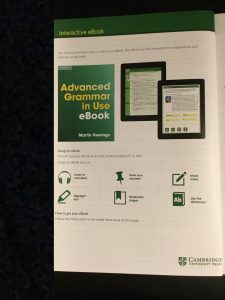
Using the eBook
You can use your eBook on an iPad, Android tablet, PC or Mac.
Using the eBook you can:
Listen to examples
Save your answers
Make notes
Highlight text
Bookmark pages
Use the dictionary
How to get your eBook
Follow the instructions in the inside front cover of this book.
サンプルページAdvanced Grammar in Use
サンプル – Advanced Grammar in Use Book with Answers and Interactive eBookも確認する
も確認する。

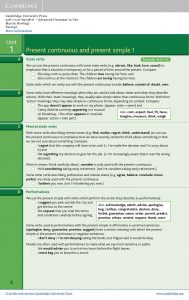
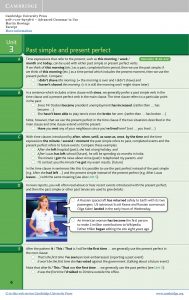
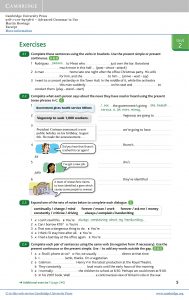
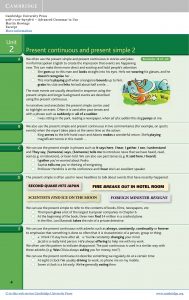
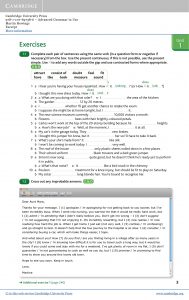
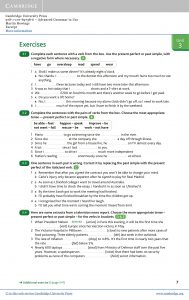
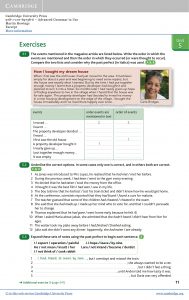
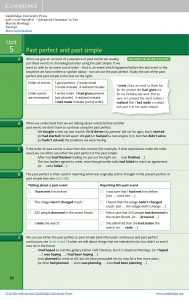
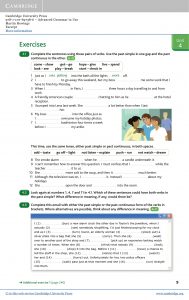
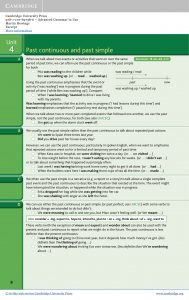
目次 – Essential Grammar in Use with Answers and Interactive eBook
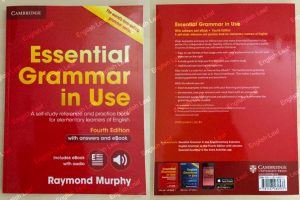
Contents
Acknowledgements
To the student
To the teacher
Interactive eBook
Present
1 am/is/are
2 am/is/are (questions)
3 I am doing (present continuous)
4 are you doing? (present continuous questions)
5 I do/work/like etc. (present simple)
6 I don’t … (present simple negative)
7 Do you … ? (present simple questions)
8 I am doing (present continuous) and I do (present simple)
9 I have … and I’ve got …
Past
10 was/were
11 worked/got/went etc. (past simple)
12 I didn’t … Did you … ? (past simple negative and questions)
13 I was doing (past continuous)
14 I was doing (past continuous) and I did (past simple)
Present perfect
15 I have done (present perfect 1)
16 I’ve just … I’ve already… I haven’t … yet (present perfect 2)
17 Have you ever … ? (present perfect 3)
18 How long have you … ? (present perfect 4)
19 for since ago
20 I have done (present perfect) and I did (past)
Passive
21 is done was done (passive 1)
22 is being done has been done (passive 2)
Verb forms
23 be/have/do in present and past tenses
24 Regular and irregular verbs
Future
25 What are you doing tomorrow?
26 I’m going to…
27 will/shall 1
28 will/shall 2
IF YOU ARE NOT SURE WHICH UNITS TO STUDY, USE THE STUDY GUIDE ON PAGE 271
Modals, imperative etc.
29 might
30 can and could
31 must mustn’t don’t need to
32 should
33 I have to …
34 Would you like …? I’d like…
35 Do this! Don’t do that! Let’s do this!
36 I used to …
There and it
37 there is there are
38 there was/were there has/have been there will be
39 It …
Auxiliary verbs
40 I am, I don’t etc.
41 Have you? Are you? Don’t you? etc.
42 too/either so am I/neither do I etc.
43 isn’t, haven’t don’t etc. (negatives)
Questions
44 is it … ? have you … ? do they … ? etc. (questions 1)
45 Who saw you? Who did you see? (questions 2)
46 Who is she talking to? What is it like? (questions 3)
47 What …? Which …? How …? (questions 4)
48 How long does it take … ?
49 Do you know where …? I don’t know what … etc.
Reported speech
50 She said that … He told me that …
-ing and to …
51 work/working go/going do/doing
52 to… (I want to do) and -ing (I enjoy doing)
53 I want you to … I told you to …
54 I went to the shop to …
Go, get, do, make and have
55 go to … go on… go for … go-ing
56 get
57 do and make
58 have
Pronouns and possessives
59 l/me he/him they/them etc.
60 my/his/their etc.
61 Whose is this? It’s mine/yours/hers etc.
62 l/me/my/mine
63 myself/yourself/themselves etc.
64 -‘s (Kate’s camera / my brother’s car etc.)
IF YOU ARE NOT SURE WHICH UNITS TO STUDY, USE THE STUDY GUIDE ON PAGE 271
A and the
65 a/an…
66 train(s) bus(es) (singular and plural)
67 a bottle / some water (countable/uncountable 1)
68 a cake / some cake / some cakes (countable/uncountable 2)
69 a/an and the
70 the…
71 go to work go home go to the cinema
72 I like music I hate exams
73 the… (names of places)
Determiners and pronouns
74 this/that/these/those
75 one/ones
76 some and any
77 not + any no none
78 not + anybody/anyone/anything nobody/no-one/nothing
79 somebody/anything/nowhere etc.
80 every and all
81 all most some any no/none
82 both either neither
83 a lot much many
84 (a) little (a) few
Adjectives and adverbs
85 old/nice/interesting etc. (adjectives)
86 quickly/badly/suddenly etc. (adverbs)
87 old/older expensive / more expensive
88 older than … more expensive than …
89 not as … as
90 the oldest the most expensive
91 enough
92 too
Word order
93 He speaks English very well. (word order 1)
94 always/usually often etc. (word order 2)
95 still yet already
96 Give me that book! Give it to me!
Conjunctions and clauses
97 and but or so because
98 When …
99 If we go … If you see … etc.
100 If I had … If we went … etc.
101 a person who … a thing that/which … (relative clauses 1)
102 the people we met the hotel you stayed at (relative clauses 2)
IF YOU ARE NOT SURE WHICH UNITS TO STUDY, USE THE STUDY GUIDE ON PAGE 271
Prepositions
103 at 8 o’clock on Monday in April
104 from … to until since for
105 before after during while
106 in at on (places 1)
107 in at on (places 2)
108 to in at (places 3)
109 under, behind, opposite etc.
110 up, over, through etc.
111 on at by with about
112 good at …, interested in … etc. of/at/for etc. (prepositions) +-ing
113 listen to … , look at … etc. (verb + preposition)
Phrasal verbs
114 go in, fall off, run away etc. (phrasal verbs 1)
115 put on your shoes put your shoes on (phrasal verbs 2)
Appendices
Appendix 1 Active and passive
Appendix 2 List of irregular verbs
Appendix 3 Irregular verbs in groups
Appendix 4 Short forms (he’s / I’d / don’t etc.)
Appendix 5 Spelling
Appendix 6 Phrasal verbs (take off / give up etc.)
Appendix 7 Phrasal verbs + object (put out a fire / give up your job etc.)
Additional exercises
Study guide
Key to Exercises
Key to Additional exercises
Key to Study guide
Index
IF YOU ARE NOT SURE WHICH UNITS TO STUDY, USE THE STUDY GUIDE ON PAGE 271
Acknowledgements
Design
Kamae Design
Illustrations Adz, Paul Boston, Christopher Flint, John Goodwin, Katie Mac, Martina – KJA artists, Lucy Truman
Digital development
Datamatics Ltd.
To the student (working without a teacher)
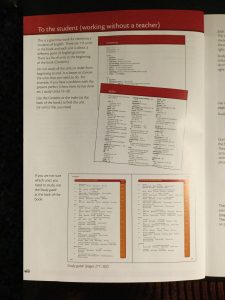
This is a grammar book for elementary students of English. There are 115 units in the book and each unit is about a different point of English grammar. There is a list of units at the beginning of the book (Contents).
Do not study all the units in order from beginning to end. It is better to choose the units that you need to do. For example, if you have a problem with the present perfect (I have been, he has done etc.), study Units 15-20.
Use the Contents or the Index (at the back of the book) to find the unit (or units) that you need.
If you are not sure which units you need to study, use the Study guide at the back of the book
Study guide (pages 271-282)
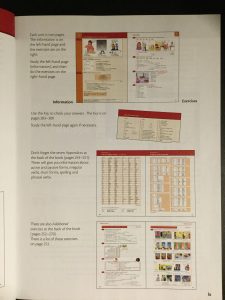
Each unit is two pages. The information is on the left-hand page and the exercises are on the right:
Study the left-hand page (information), and then do the exercises on the right-hand page.
Use the key to check your answers. The Key is on pages 283-309.
Study the left-hand page again if necessary.
Don’t forget the seven Appendices at the back of the book (pages 243-251). These will give you information about active and passive forms, irregular verbs, short forms, spelling and phrasal verbs.
There are also Additional exercises at the back of the book (pages 252-270). There is a list of these exercises on page 252
To the teacher
The most important features of this book are:
It is a grammar book. It does not deal with other aspects of the language.
It is for elementary learners. It does not cover areas of grammar which are not normally taught at elementary level.
It is a reference book with exercises. It is not a course book and is not organised progressively.
It is addressed to learners and intended for self-study.
Organisation of the book
There are 115 units in the book, each one focusing on a particular area of grammar. The material is organised in grammatical categories, such as tenses, questions and articles. Units are not ordered according to difficulty. and should therefore be selected and used in the order appropriate for the learner(s). The book should not be worked through from beginning to end.
The units are listed in the Contents and there is a comprehensive Index at the end of the book.
Each unit has the same format consisting of two facing pages. The grammar point is presented and explained on the left-hand page and the corresponding exercises are on the right. There are seven Appendices (pages 243-251) dealing with active and passive forms, irregular verbs, short forms (contractions), spelling and phrasal verbs. It might be useful for teachers to draw students’ attention to these.
At the back of the book there is a set of Additional exercises (pages 252-270). These exercises provide ‘mixed’ practice bringing together grammar points from a number of different units (especially those concerning verb forms). There are 35 exercises in this section and there is a full list on page 252.
Also at the back of the book there is a Study guide to help students decide which units to study – see page 271.
Finally, there is a key (pages 283-309) for students to check their answers to all the exercises in the book. An edition without the Study guide and Key is available for teachers who would prefer it for their students.
Level
The book is for elementary learners, i.e. learners with very little English, but not for complete beginners. It is intended mainly for elementary students who are beyond the early stages of a beginners’ course. It could also be used by low-intermediate learners whose grammar is weaker than other aspects of their English or who have problems with particular areas of basic grammar.
The explanations are addressed to the elementary learner and are therefore as simple and as short as possible. The vocabulary used in the examples and exercises has also been restricted so that the book can be used at this level.
Using the book
The book can be used by students working alone (see To the student) or as supplementary course material. In either case the book can serve as an elementary grammar book.
When used as course material, the book can be used for immediate consolidation or for later revision or remedial work. It might be used by the whole class or by individual students needing extra help and practice.
In some cases it may be desirable to use the left-hand pages (presentation and explanation) in class, but it should be noted that these have been written for individual study and reference. In most cases, it would probably be better for teachers to present the grammar point in their preferred way with the exercises being done for homework. The left-hand page is then available for later reference by the student.
Some teachers may prefer to keep the book for revision and remedial work. In this case, individual students or groups of students can be directed to the appropriate units for self-study and practice.
Interactive eBook
You can buy this book with or without an eBook. The eBook has the same grammar explanations and exercises as the book
.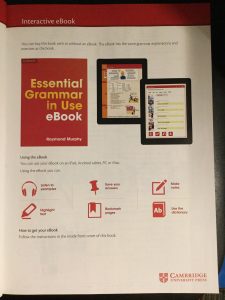
Using the eBook
You can use your eBook on an iPad, Android tablet, PC or Mac.
Using the eBook you can:
Listen to examples
Save your answers
Make notes
Highlight text
Bookmark pages
Use the dictionary
How to get your eBook
Follow the instructions in the inside front cover of this book.
CAMBRIDGE UNIVERSITY PRESS
サンプルページEssential Grammar in Use
サンプルページ – Essential Grammar in Use with Answers and Interactive eBook
も確認する。

